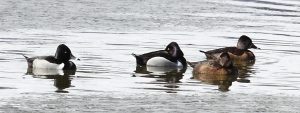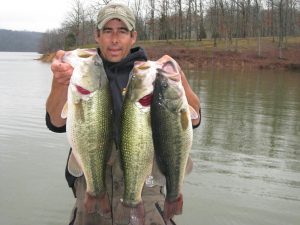
Photo: Kentucky Department Fish And Wildlife
The outlook for the upcoming waterfowl hunting seasons looks as promising as any seasons in recent memory.
“It is shaping up to be a phenomenal year,” said John Brunjes, migratory bird coordinator for the Kentucky Department of Fish and Wildlife Resources. “We are still at all-time highs for duck numbers with as many breeding ducks as we’ve ever had. It’s been that way for a couple of years now.”
Brunjes said biologists conducted duck population counts along the Mississippi River in Illinois last week. They produced four times the normal number of birds counted. “Usually for the second week of November in Illinois, they see about 200,000 birds,” he said. “They counted 800,000 birds along the Mississippi River last week and those birds are heading our way.”
Waterfowl of all stripes are migrating through Kentucky right now. “We are seeing white-fronted geese and even tundra swans in southeast Kentucky,” Brunjes said. “It is very rare. We have a ton of snow geese showing up in weird places this year. The birds are moving well this year.”
The duck, coot, and merganser seasons all open Thanksgiving Day, Nov. 23. The opening segment of the hunting season for ducks, coots and mergansers runs until Nov. 26. These seasons open again Dec. 4, 2017, and close Jan. 28, 2018.
The hunting season for Canada, white-fronted, brant and snow geese also open Thanksgiving Day, but do not close until Feb. 15, 2018.
“We want to remind hunters there is an extended opportunity for geese,” Brunjes said. “The extended season went into effect last year.” Traditionally, goose seasons closed in late January.
A summer devoid of long dry periods set the table for excellent waterfowl habitat this fall. “The moist soil areas and native vegetation look really good,” Brunjes said. “The crops on our wildlife management areas (WMAs) did well. We have the best crops at Ballard WMA that we’ve had in a number of years.”
Finding a place to waterfowl hunt is a challenge for the majority of Kentucky hunters. The first place to check is the public land hunting section of the 2017-2018 Kentucky Hunting Guide for Waterfowl. This section details the hunting options and regulations on public lands, mainly wildlife management areas.
Many, but not all, of the smaller state-owned or managed lakes are open to waterfowl hunting as are reservoirs operated by the U.S. Army Corps of Engineers or the U.S. Forest Service. The bigger waters hold more birds during the coldest stretches of the year, when many farm ponds or smaller lakes freeze over. Call the Kentucky Fish and Wildlife information center at 1-800-858-1549 to inquire if a lake is open to waterfowl hunting.
Those pursuing waterfowl on reservoirs must not hunt near access areas such as boat ramps or areas closed to hunting or public access by signs. Common sense and courtesy dictates waterfowl hunters avoid setting up near private residences or marinas.
Scouting is vitally important to waterfowl hunting success, especially in the first month of the season.
“If you aren’t seeing any birds in the areas you hoped to hunt prior to opening day, you likely won’t see birds on opening weekend either,” Brunjes said. “You have to find the areas birds are using and set up accordingly.”
Waste corn in cut silage fields provides excellent food for ducks and geese. Goose hunters may find agreeable farmers who consider geese a nuisance. Goose hunting in harvested cornfields provides excellent sport and peaks with the coldest weather.
Those farmers may also grant permission to hunt their ponds. From the air, farm ponds dot the Kentucky landscape as craters do the Moon. They can provide the hottest hunting, but not all farm ponds attract birds. Scouting is vital for successful farm pond hunting.
Waterfowl hunters must have a valid Kentucky hunting license, a Kentucky migratory game bird – waterfowl permit along with a Federal Duck Stamp. Federal Duck Stamps are available at post offices across Kentucky.
Waterfowl hunters must have their Harvest Information Program (H.I.P.) confirmation number recorded on either their Kentucky hunting license or on their Kentucky migratory game bird – waterfowl permit. To get your H.I.P. number, visit the Kentucky Fish and Wildlife website at www.fw.ky.gov and click on the “My Profile” tab. Answer a few questions about last season’s harvest of migratory birds to receive your confirmation number. The process takes less than 5 minutes.
“Folks in the neighboring states to our north such as Illinois, where waterfowl seasons are already open, are having great hunting so far,” Brunjes said. “It is early and a lot remains to be seen, but everything is setting up for a great season.”

Photo: Kentucky Department Fish and Wildlife
June is one of the best months for outside activities such as fishing. However, many predator species, such as largemouth bass, have already completed their annual reproductive ritual and kind of sulk through June.
It can be a tough month for fishing in lakes and reservoirs, but two options will produce fishing that compares to the marvelous weather.
Largemouth bass in farm ponds:
June is a transitional month for largemouth bass in our larger lakes, but the confined nature of a farm pond ups the odds in the angler’s favor.
“You can catch largemouth bass all summer in a farm pond,” said Jeff Ross, assistant director of fisheries for the Kentucky Department of Fish and Wildlife Resources.
Successful summer largemouth bass fishing in farm ponds is all about timing and changing approaches as the day progresses. Wake up early enough that dew soaks your shoes as you walk to the pond.
Old school topwater lures such as the Hula Popper or a Jitterbug in the bullfrog color draw vicious strikes when slowly worked along the edge of vegetation in the low light of early morning.
As the sun rises, switch to fishing a weightless 7-inch ribbon-tailed worm in the junebug color. “Bass hold tight to cover during the middle of the day on a farm pond,” Ross said. “Fish the shady side of the pond if there is one.”
The weightless ribbon-tailed worm slowly falls through the cover attracting largemouth bass snuggled deeply in it. If the pond has no cover, fish the worm slowly along any weedlines or under any floating vegetation.
As day fades into night, the topwater bite again comes into play. Anglers also catch many farm pond bass in the dark on a 1/4-ounce black spinnerbait with a round Colorado blade.
Fish the spinnerbait just above bottom and let the Colorado blade thump. Hold on tight as largemouth bass often savage this presentation.
Channel catfish:
Channel catfish spawn in Kentucky mainly in June. “They are cavity spawners,” Ross said. “You often find them near riprap or chunk rock.”
Riprap consists of cantaloupe-sized rock used to protect the face of dams, bridge abutments and marinas from erosion caused by the pounding of waves. A 3/8-ounce slip-sinker rig with a 4/0 circle hook is a good choice for catfish when fished on or near riprap or areas of chunk rock lining the banks.
A slip-sinker rig consists of an 18-inch fluorocarbon or monofilament leader with the circle hook on one end. Tie the other end of the leader to a barrel swivel. After threading the main line coming from your rod through an egg sinker followed by a glass bead, tie the main line to the open loop of the barrel swivel.
A circle hook prevents gut hooking catfish. Resist the temptation to set the hook, simply reel in slack line until you feel the catfish swimming and keep your rod tip high. The catfish will hook itself in the side of the mouth with a circle hook.
“Hot dogs, shrimp, chicken liver or beef liver, channel catfish will eat practically anything,” Ross said. “I like chicken liver best for channels.”
Ross also said any cavity near a root wad or stump also holds channel catfish in June on our lakes and reservoirs.
The many creeks coursing through Kentucky hold surprising numbers of channel catfish. Those with rocky bottoms and water at least chest deep are best.
Undercut banks are key to finding channel catfish in streams. Use a slip-sinker rig with enough weight to hold it in place in current. Use a 3/0 circle hook with a piece of cleaning sponge impaled on it.
Drop the sponge into a tub of commercially made stink bait, also called dip bait, and push it to the bottom with a stick. Hold it there to soak up as much of the smelly dip bait as the sponge can hold and cast it to an undercut bank. The sponge emits a plume of funk downstream that channel catfish follow back to the sponge and eat it.
You can also use chicken livers, nightcrawlers or rancid cheese for this presentation, but the dip bait sponge is hard to beat in a stream. You will catch many 16- to 21-inch long channel catfish in streams, perfect size for a dinner. Channel catfish from a cool stream offer fantastic table fare.
June is a wonderful month weather wise, but a transition time as predator fish move into their summer locations. Farm pond largemouth bass and channel catfish provide excellent sport during this unpredictable month.
 Weather
Weather Traffic
Traffic @LouisvilleDispatch
@LouisvilleDispatch @LouisvilleDisp
@LouisvilleDisp Subscribe
Subscribe
